Team Experience is passing West Side Story around in honor of Leonard Bernstein's Centennial
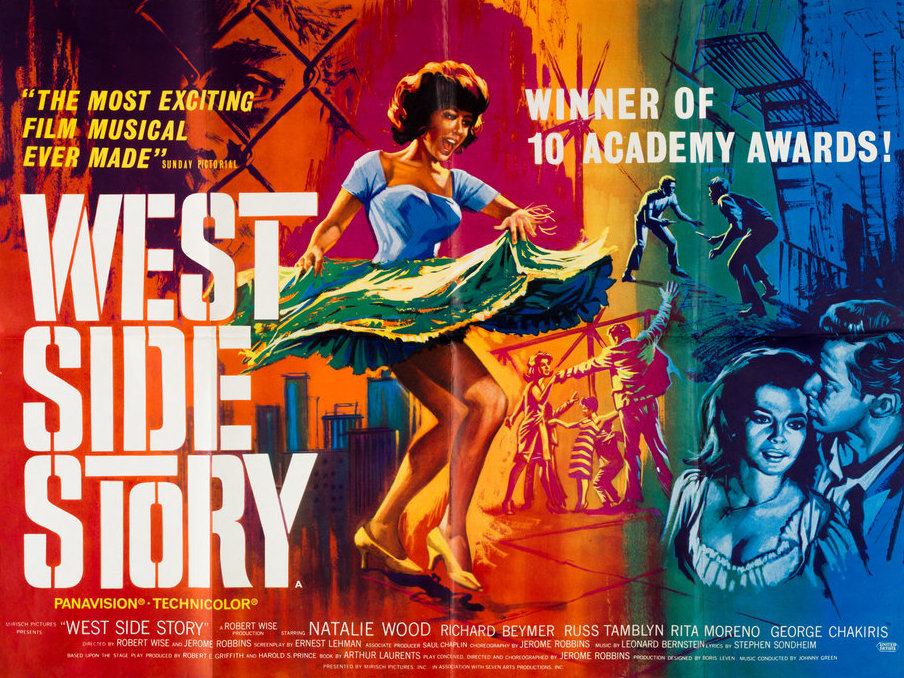
In part one Lynn brought us through the first 50 spectacular minutes of West Side Story, tossing the baton to me exactly at one of the film’s highlights, "America" where Anita (Oscar-winning Rita Moreno) and Bernardo (Oscar-winning George Chakiris) have begun to argue about their lives and opportunities as immigrants...
Part 2 by Eric Blume
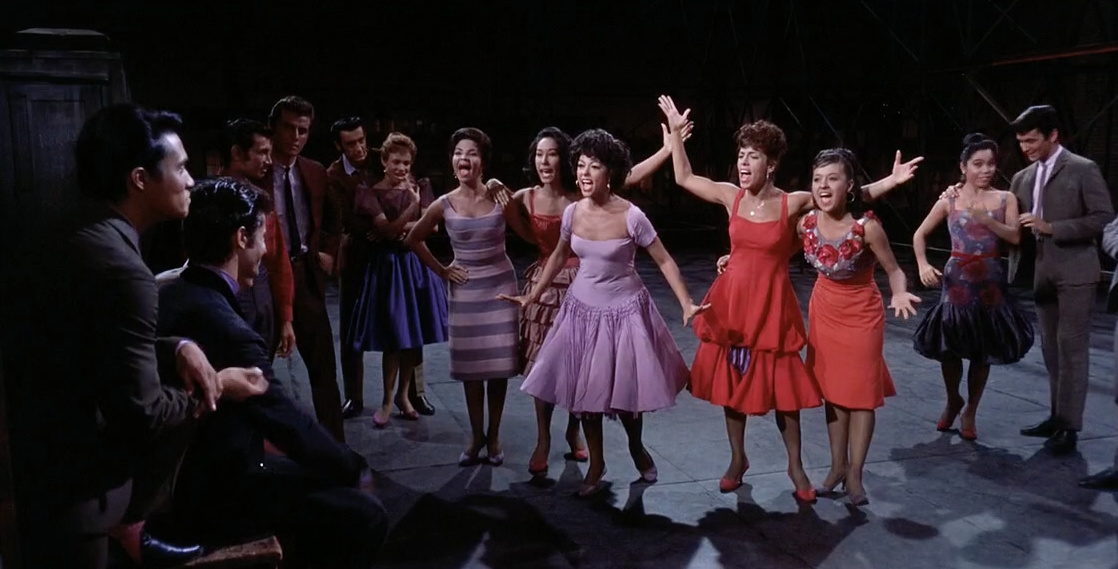
50:32 The first thing you should note about the transition from the first refrain to the full number is a lovely piece of blocking where everyone rearranges themselves for a slightly different tableau, while the camera remains blessedly static. Robert Wise and Jerome Robbins, co-directing, had great filmmakers instincts for when to keep something “theatrical” (in this case, proscenium with a change in blocking) and when to do something “cinematic” (e.g., cutting, which they do throughout this number mostly to highlight individual performance lines).
Quite simply, there are few dance numbers in cinema equal to “America”...
Dramatically, it works so well because it’s an argument between two central characters in conflict, commenting on the larger themes of the film. Stephen Sondheim, who provided the lyrics, has said that the number was originally intended to be an Anita/Bernardo exchange for the Broadway production, but Jerome Robbins insisted on an all-girl number; Robbins changed his mind, thankfully, for the film version. All subsequent stage versions feel weaker with the men removed from the number, not only because the number becomes physically smaller, but also because you’ve lost a fiery dimension of the secondary lovers in the piece.

Girls: Skyscrapers bloom in America, Cadillacs zoom in America, Industry boom in a America
Boys: 12 in a room in America
51: 06 This shot displays Robbins’ witty sense of humor and uncanny sense of staging. The ease and grace with which these dancers pull themselves together for this image is beautiful, and it further speaks to how the Sharks are always in function as a team.
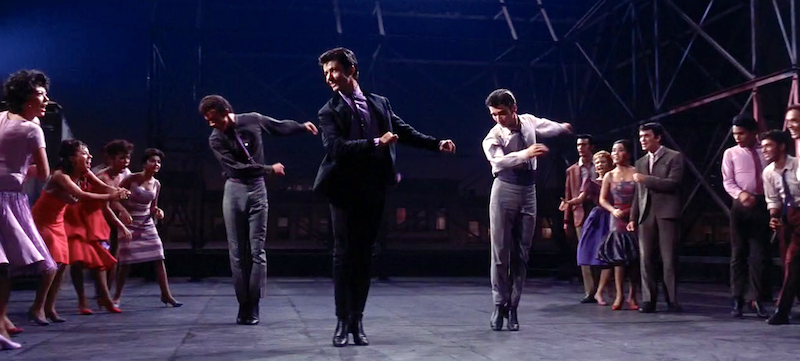
51:37 This is our first wide shot with the men dancing. Part of the miracle of this number is that it’s shot and edited in a series of expanding wide shots, so we get that unique thrill of seeing entire bodies dance (in large groups, no less), but also with varying framing, against different backdrops. In this shot, you’ll see a skyline of other buildings in the background… but by the end of the number, the dancers are clearly on a set, complete with a brick wall as if in the back of a theater. I was struck by this influence in Damien Chazelle’s La La Land, in which he makes many of his practical shooting locations look like sets, and some of his sets go for even further towards stylization.
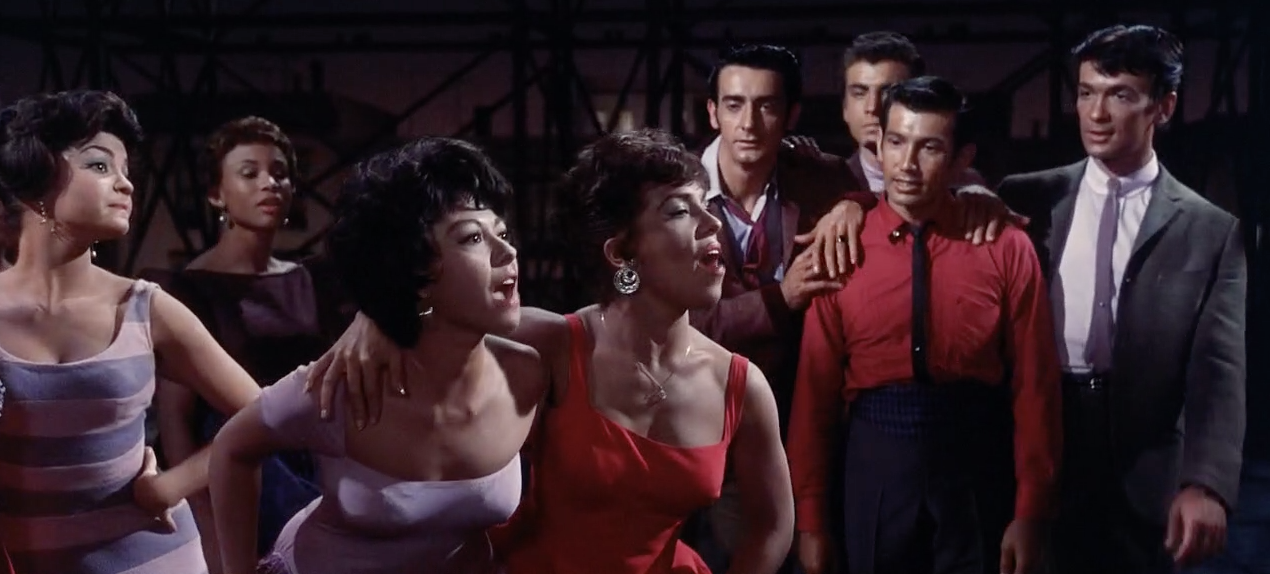
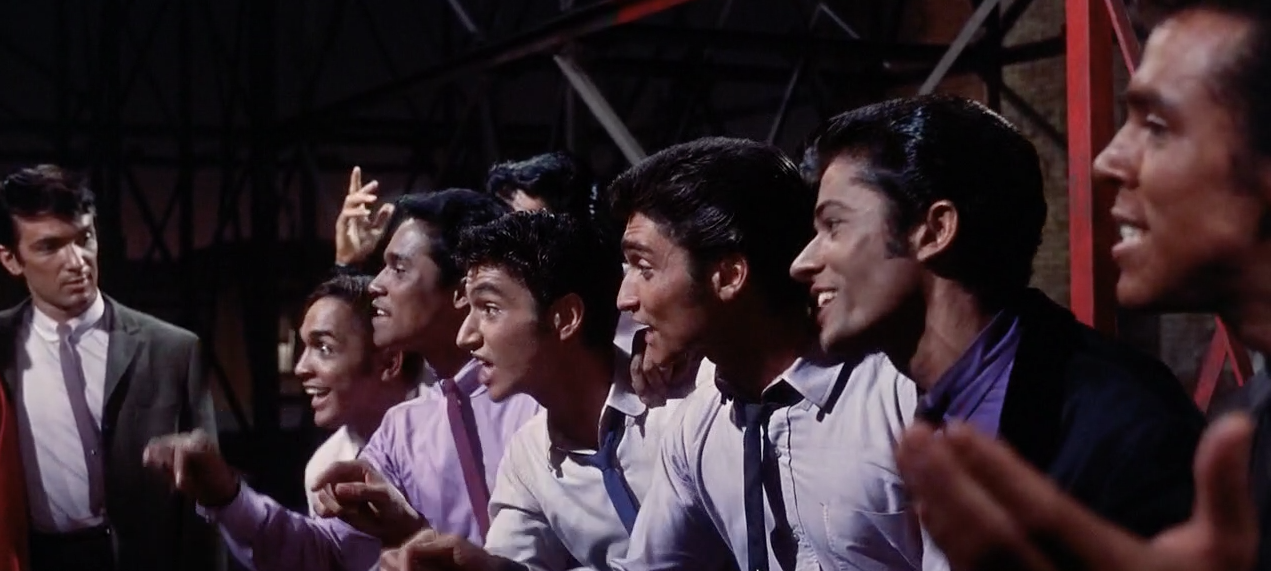
Girls: Here you are free and you have rights
Boys: Long as you stay on your own side.
52:16 Wise and Robbins make a smart choice here: in this final exchange between the women and the men, they break out of the wide, and go in to a medium close, with a soft, swinging pan back and forth between the singers. Locking them in a wide for this portion would be a far less interesting choice.
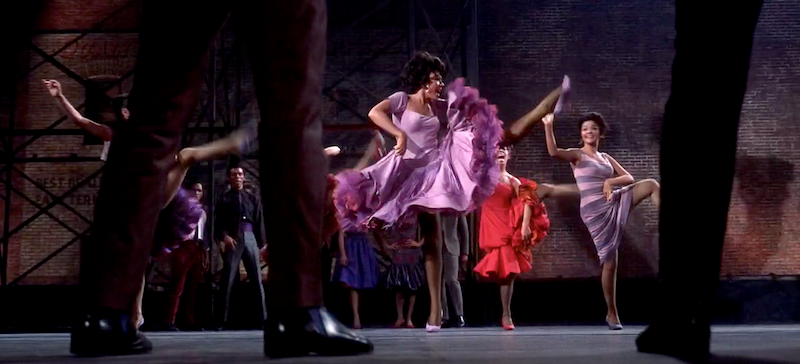
52:59 This framing, which has two of the Shark men walking in front of, then standing in front of, the girls dancing, goes against how all movie dancing was previously shot. They’re completely blocking two of the five dancers! It’s part of Wise and Robbins’ smart use of the cinema…this image could never happen on a stage.
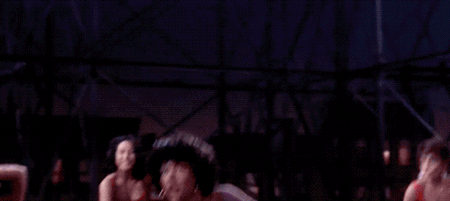
53:03 Rita. I can’t even! Rita Moreno and the purple dress. Surely Rita’s performance is one of our most richly deserved Best Supporting Actress winners ever, and certainly this purple dress has to be one of the best costumes ever? The stunning dark purple revealed under its lilac exterior not only looks incredible, it feels like it represents Moreno and her characterization: the soft, ripe feminine warmth, with the passion and fire raging underneath.
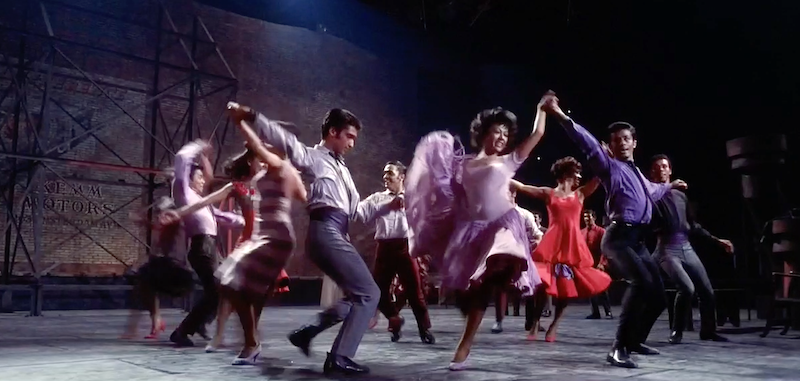
54:23 The vibrant and sexy use of color in this number is legend, so it’s obvious and probably pedestrian to address it, but what’s fun towards the end of the number with both crane shots from above and cameras on ground is that it’s the first time we can really see and feel that they’re just on a big dance floor set, full of gray dust from their shoes. When we started, the filmmakers went to lengths for us to “buy” that we were on a “real” (if stylized) Manhattan rooftop. But we’re really in a blissful mental space of Wise and Robbins’ making: they get you to suspend your disbelief because you’re on such a wave of pure joy. That’s what musicals are about.
“America” is such a killer number because everything comes together from some of our greatest-ever American artists at the peak of their powers: Bernstein’s ferocious and exciting music; Sondheim’s crisp, funny lyrics; and of course Jerome Robbins’ knockout choreography. Robbins allowed these dancers to all be actors: they’re not “doing steps” but rather always have something specific and purposeful to play. You can feel their joy doing this number, there’s sex and fire and comedy in it, and the consistently intelligent and inspired choices by the filmmakers on how to shoot it cement it as a classic.
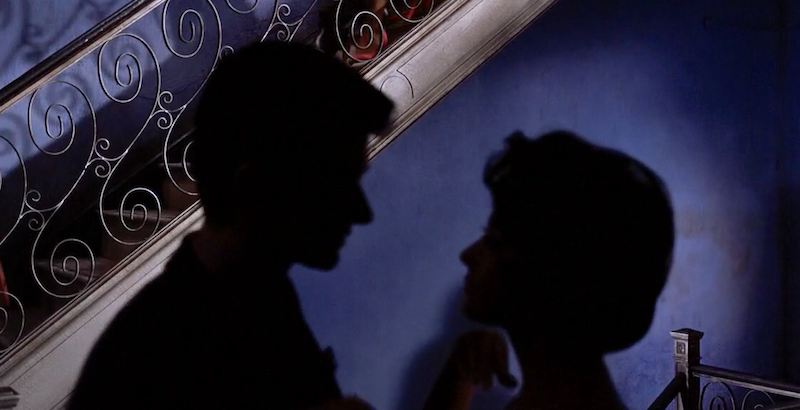
55:00 A throwaway moment, but look at the color and architecture in this shot!
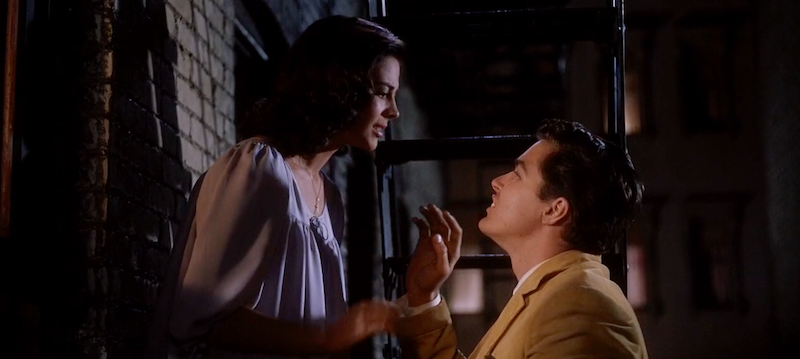
57:05 After all that purple and red, it’s lovely to see Richard Beymer in that yellow suitjacket. One can argue about the performances of Beymer and Natalie Wood in this movie, but I feel they’re perfect because despite their sometimes stilted line readings, they are lit from within. They look and feel like the incarnation of first, stupid, crazy love.
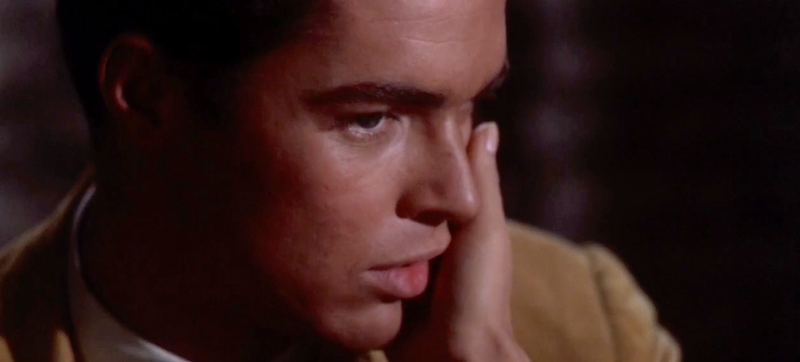
58:38 Beymer looks beautiful here. I believe he’s hopelessly lost in love. His kiss on her hand feels charged with lust and possibility.
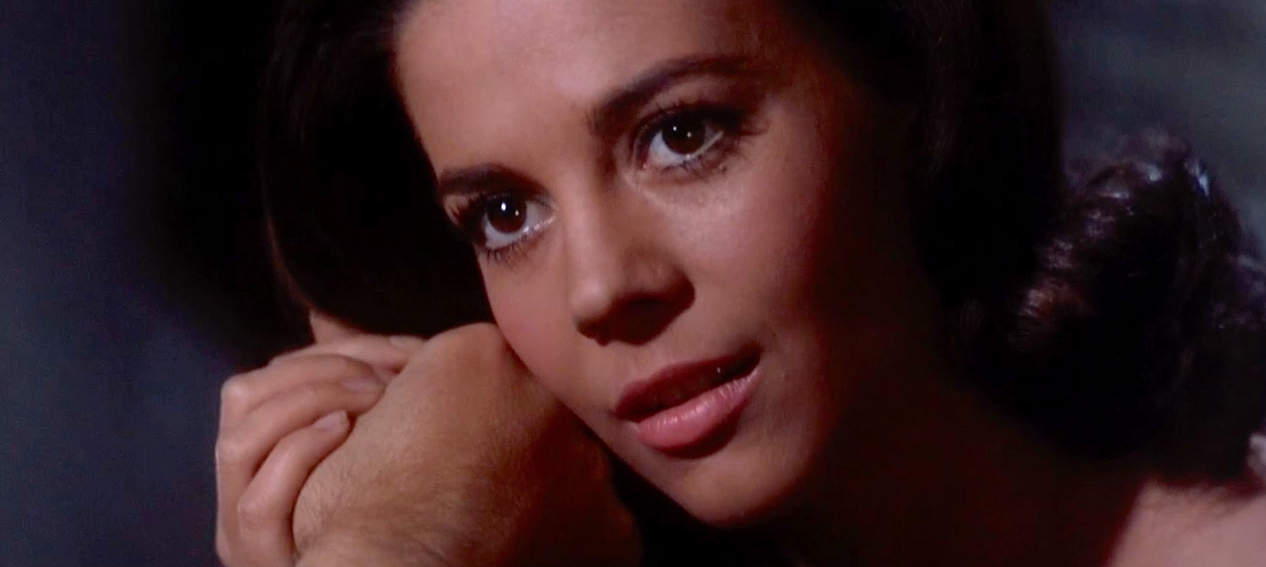
59:01 Natalie: what an incredible beauty, and such talent. She and Beymer do feel like the only two people on earth during this “Tonight” number.
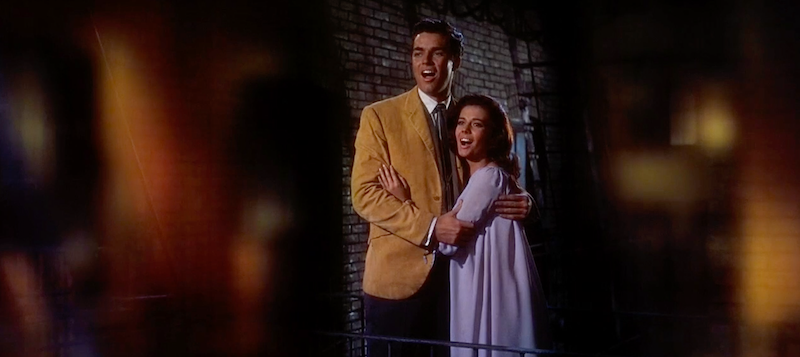
59:50 This lighting cue kicks in very slowly, until we’re left with this completely stylized image. “Suns and moons all over the place” indeed. This yellow light cue mirrors the red light cue from the “Dance at the Gym” sequence… isolating the two of them as the only elements in the frame.
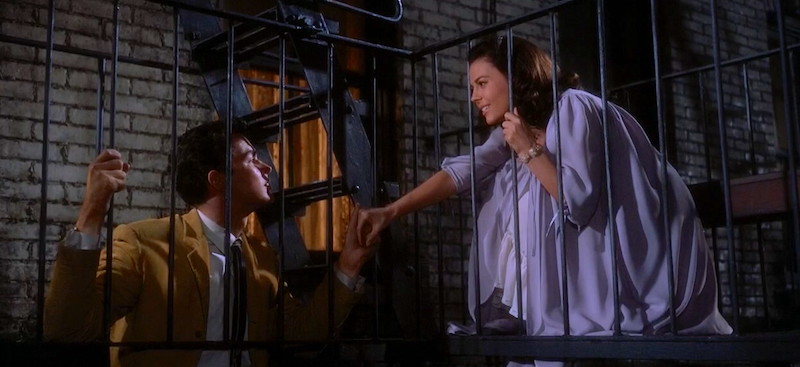
1:01:39 This image, of Tony and Maria splitting the screen with their clasped hands, both trapped behind bars yet still touching, sums up the story as strongly as any.
Tony, when you come, use the back door."
1:01:48 This line sent me into a fit of the giggles! I’m guessing it's been adjusted in current stage incarnations?
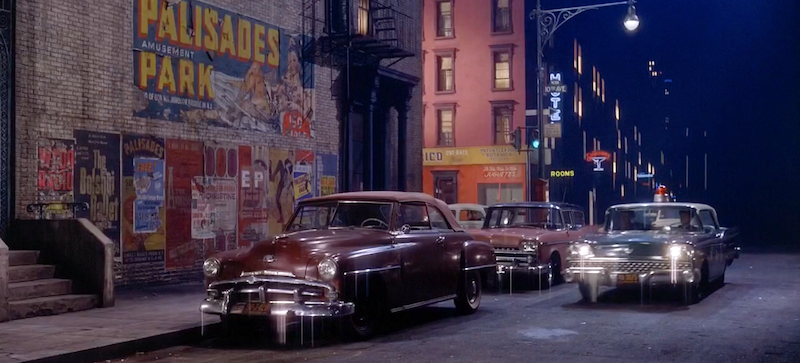
1:04:59 I’m obsessed with this Dick Tracy meets Edward Hopper shot.
1:06:51 “Gee, Officer Krupke” has the difficult challenge of being the comic number in the piece, but the filmmakers made a fantastic decision to move the number from its placement in the Broadway version (after the murders) to this much more appropriate spot midway through. The song allows for some gloriously Sondheim lyrics (“it’s just our bringing up-ke”), and the actors do a beautiful job of telling the story together, as the Sharks did in “America”…their chemistry together drives the number.
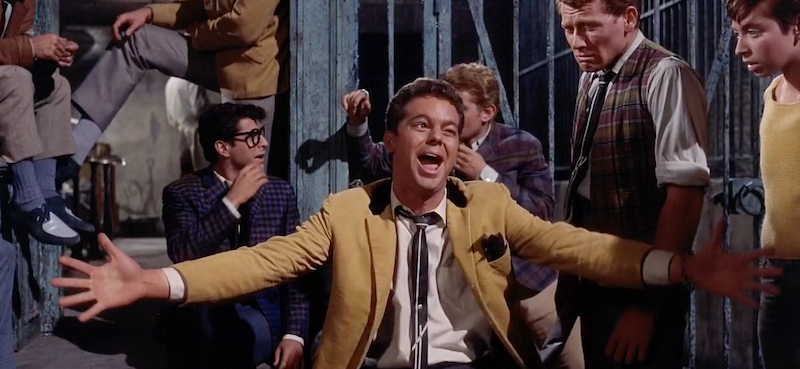
Goodness, gracious, that's why I'm a mess.
1:08:35 Russ Tamblyn does wonders with this number: he’s manic but specific, hitting all his comic beats with just the right touch of stylization, and with an unabashed showbiz bravura. All the while he keeps his characterization: he’s the sweet dickhead, who by the way, lives somewhere in most our lives. He’s the guy who’s a bit much, but also kind of irresistible.
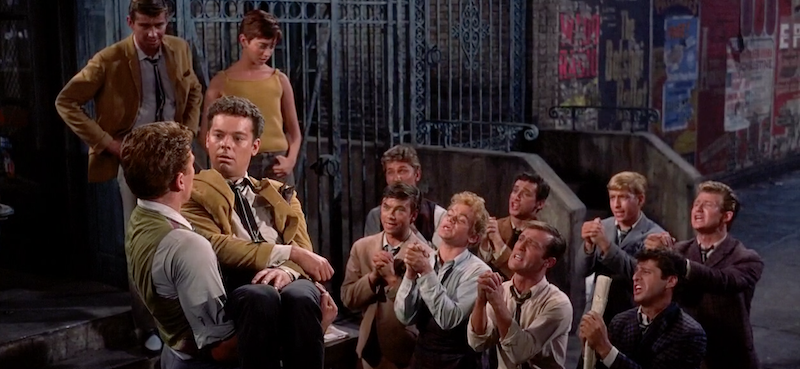
1:10:12 Another nice tableau courtesy Jerry Robbins.
INTERMISSION
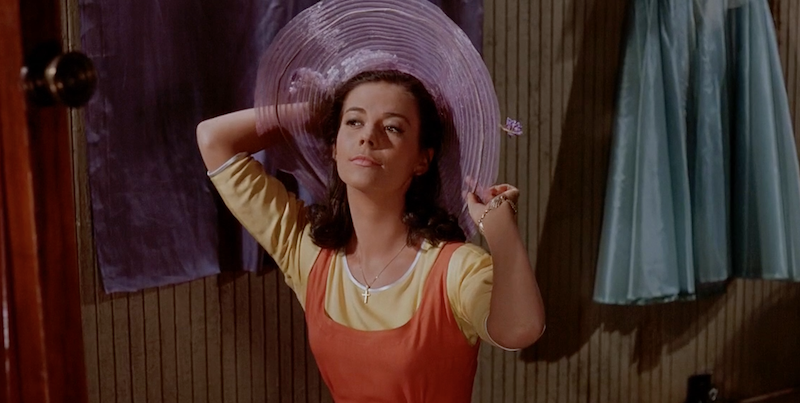
1:23:03 When we return from intermission we're in the bridal shop where Maria will sing “I Feel Pretty.” Irene Sharaff, who won one of her five Oscars for this film's costume design, now has Maria in yellow. It's a color we’ve only seen on the Jets previously. She pairs it with a purple hat, the color domain of the Sharks. A mistake? Doubtful!
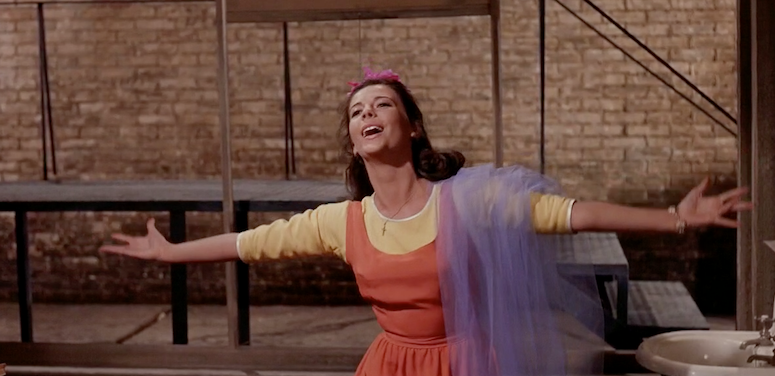
Feel like running and dancing for joy
For I'm loved by a pretty wonderful boy
1:24:37 Once again against a brick wall and scaffolding-like set design, akin to “America”. (The Oscar-winning production design was by Boris Leven, who also designed classics like Giant and The Sound of Music)
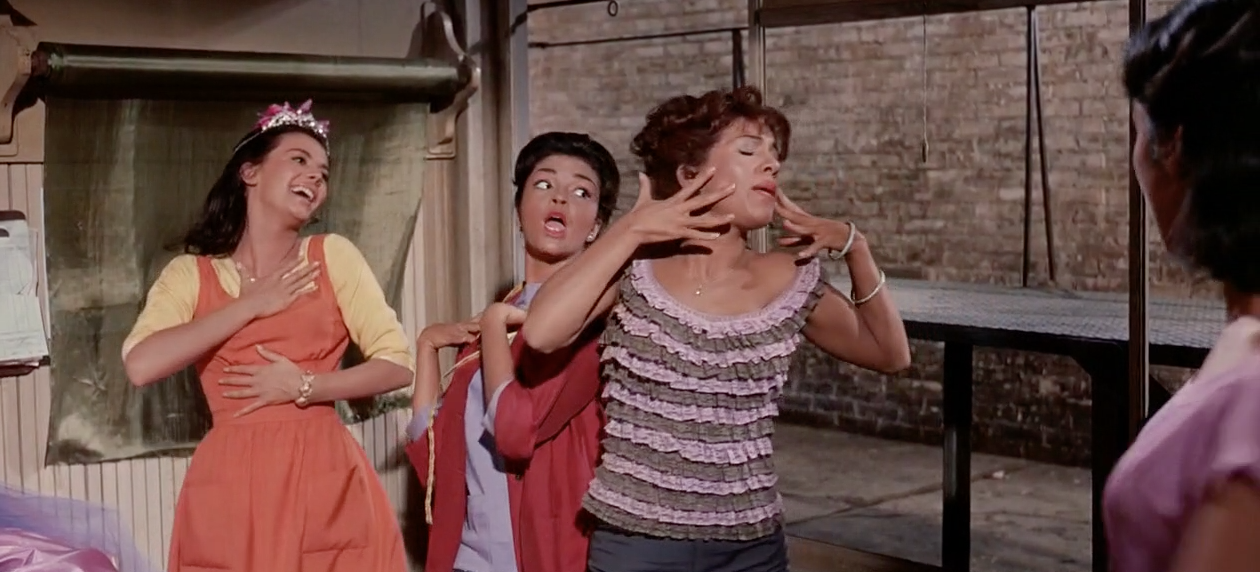
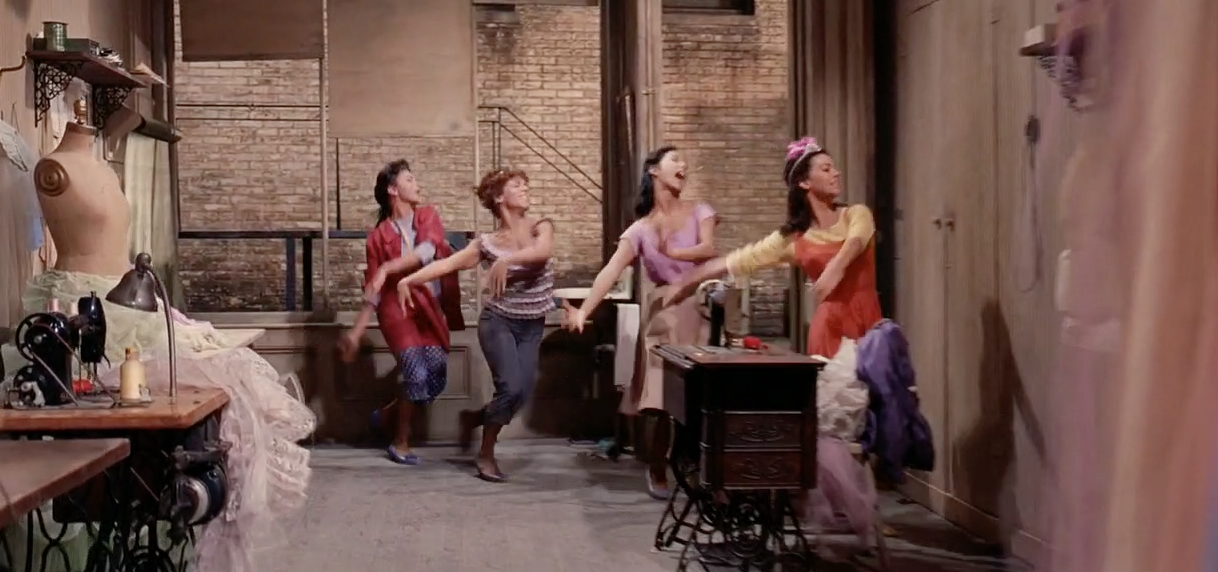
Maria: See the pretty girl in that mirror there
Girls: What mirror where?
Maria: Who can that attractive girl be?
Girls: Which? What? Where? Who?
Maria: Such a pretty face
Girls: Who?
Maria: Such a pretty dress
Girls: Who?
Maria: Such a pretty smile
Girls: Who?
Maria: Such a pretty me!
Rosalia: Such a pretty me!
Teresita: Such a pretty me!
Francesca: Such a pretty me!
1:26:02 Wise and Robbins stage this number in an alarmingly small space, so it’s clear that the more sophisticated camera movements (e.g., Maria running alongside the sheer dresses) were accomplished through a deconstruction of this set. “I Feel Pretty” isn’t the strongest of the songs in this film’s score, but it’s our last happy moment before everything goes south.
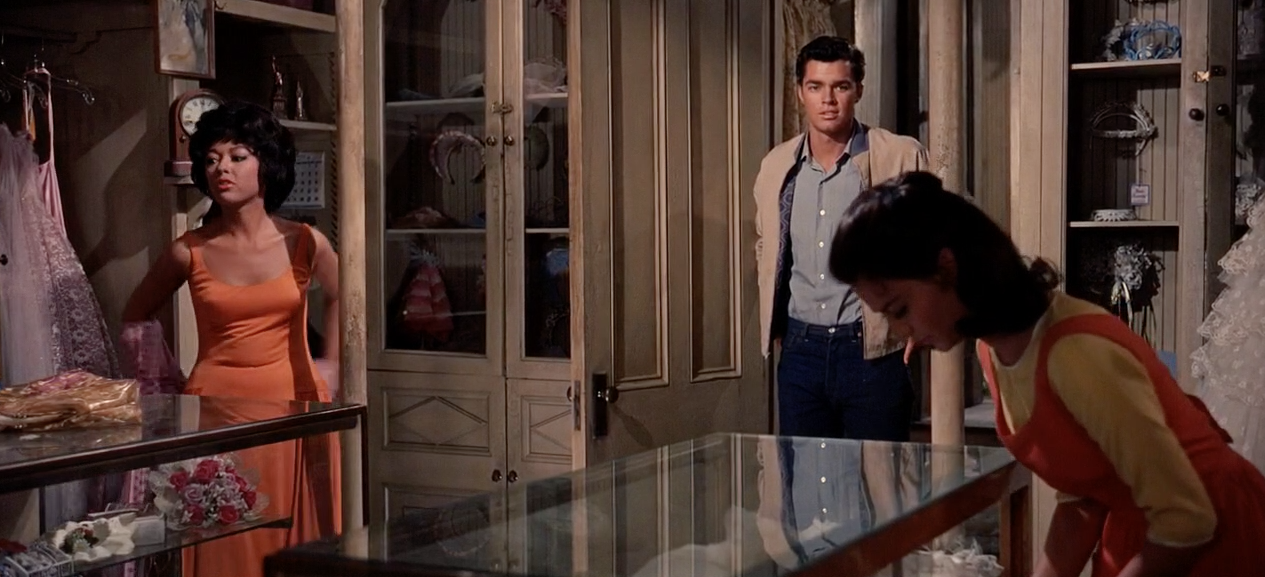
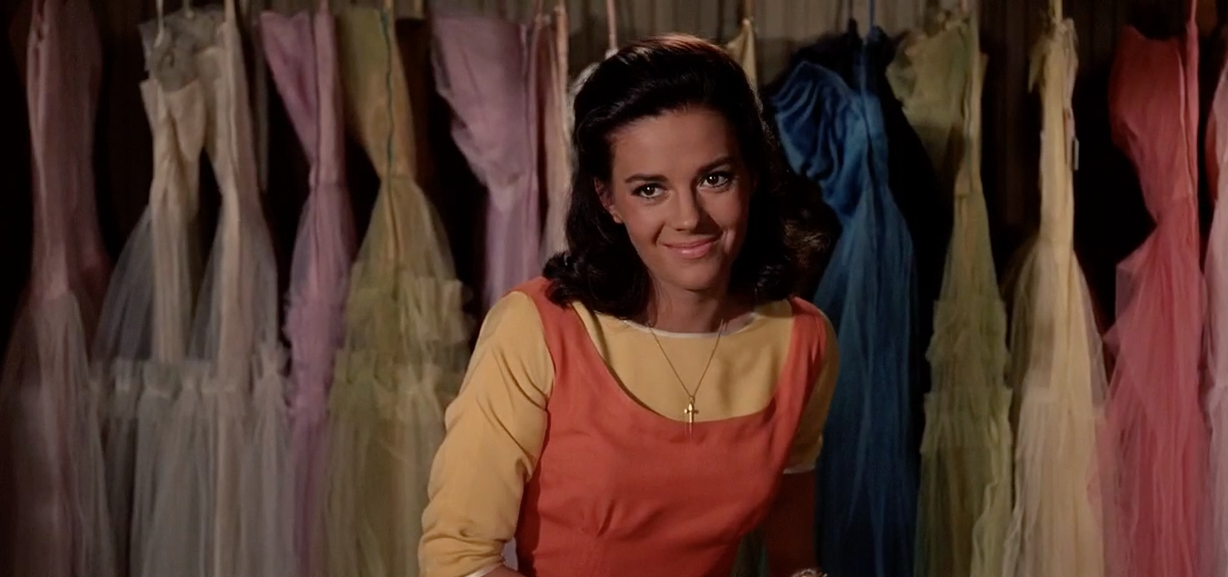
1:28:28 Nice tiny comic shrug moment for Natalie Wood here, when Rita busts her for covering up Tony’s visit to the bridal shop. The entire scene prior between Natalie and Rita, talking about the Jets and Sharks rumble to come, feels direct and true. The simplicity helps raise the stakes for their big duet together later.
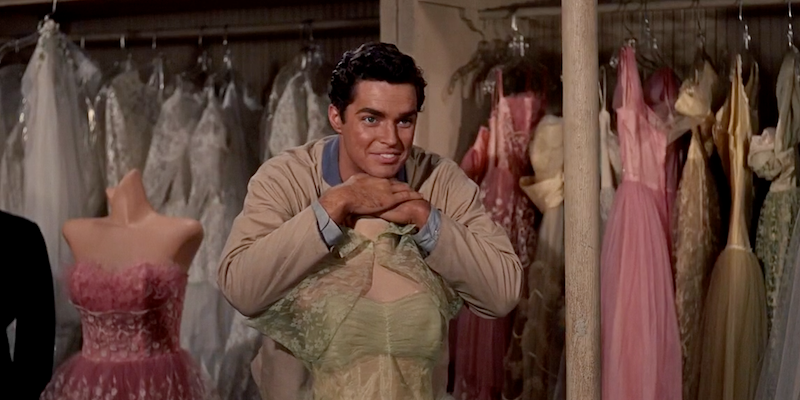
1:30:33 Another good example of how the filmmakers take you into a number by having the characters build the number together, in conjunction, on the same emotional plane. The heavy-handed “One Hand, One Heart” number comes out of Tony and Maria’s improv on how their families would meet. Beymer and Wood are wonderful in this scene. They both keep the tone so light and natural, that by the point where they begin the very serious song, they’ve surprised themselves and transported us.
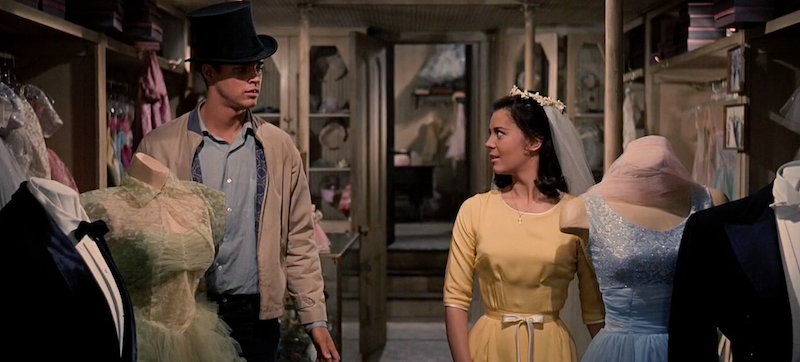
1:32:04 As the instrumental for “Somewhere” begins to play, and our lovers see each other in their top hat and bridal veil, they dare to take their comic fantasy into something richer.
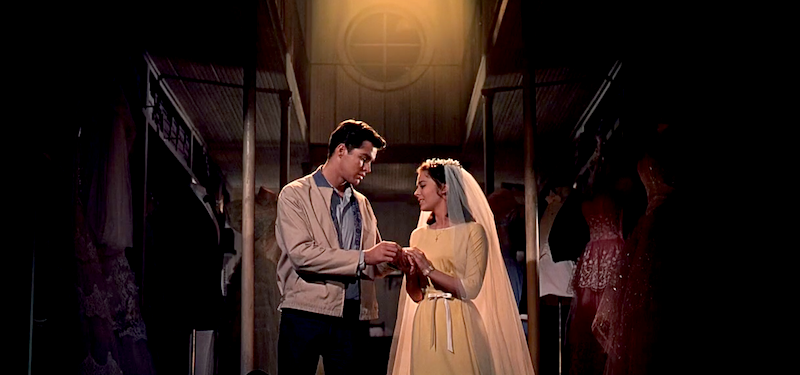
1:33:24 As “One Hand, One Heart” begins, we get another fantasy yellow light cue through the rear church-like window. Tony and Maria’s love is real, but it’s never fully in the reality of the movie …a magic haze exists around it.
Day after day, one life.
Now it begins, now we start
One hand, one heart,
Even death won't part us now.